Over the last few years I’ve made it my mission to learn how to make the softest, fluffiest, chewiest, naturally leavened bread with my sourdough starter.
This easy sourdough boule is the result of much practice and formula testing. I wanted to keep the recipe very simple and straightforward so that even an amateur sourdough baker could reproduce this bread with beautiful results! If you follow my recipe and learn the technique from watching my video you will definitely be able to master baking an artisan sourdough boule at home in your Dutch oven.
Are You Interested in the Science of Sourdough?
I’ve written a comprehensive guide to sourdough. It answers questions about what sourdough is, why it’s better for your body, how to talk about sourdough and understand common terminology, and how to save yourself years of trial and error.
Demystifying Sourdough – Everything You’ve Ever Wanted To Know About Sourdough Starter – Why It’s Better for You – And How To Start One
One of the First Steps To Making Great Bread Is Having a Great Starter!
Learn how to feed your starter for optimal performance and successful baking in my easy visual guide,
How To Feed Your Sourdough Starter for Successful Baking
Once you’ve mastered the sourdough basics you will be ready to bake an incredible loaf of bread like this one.
This Recipe Uses the Stretch and Fold Method of Kneading.
What I love about stretch and fold:
- It’s easy.
- It can be done over a period of time and at your own pace.
- It develops an insane amount of gluten, making your bread reach for the clouds with the absolute BEST oven spring.
- It’s flexible. (Only have time for two stretch and folds? No problem, you will still have an awesome bake!)
- It can be done in the bowl, keeping your workspace clean.
- You don’t need a stand mixer — stretch and fold is a “by hand” method, uniting you to your food!
This video will walk you through the steps of the recipe and stretch and fold method.
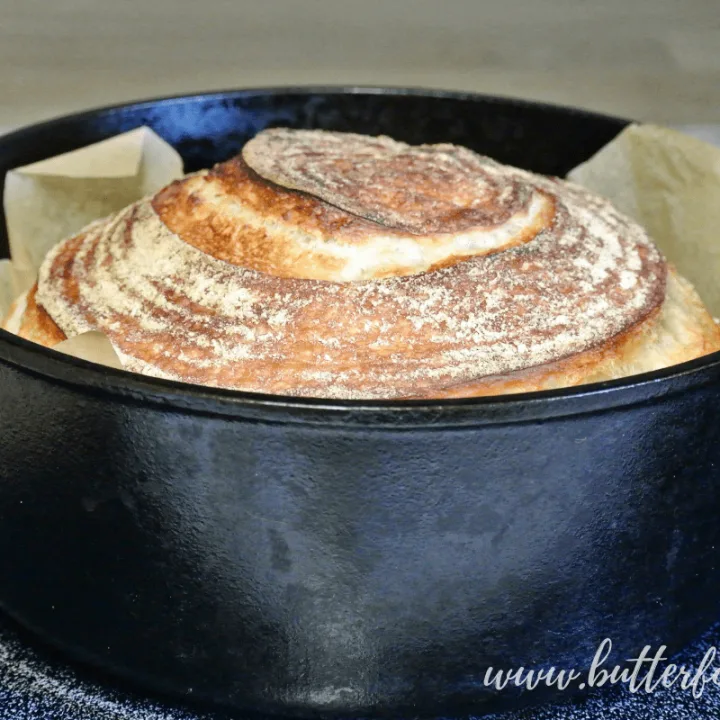
How To Bake the Perfect Sourdough Boule in Your Dutch Oven
Learn how to bake a big and beautiful loaf of real sourdough bread. This formula yields a soft and pillowy crumb perfect for slathering with real butter!
Ingredients
- 475 grams (3 1/2 cups) organic bread flour
- 315 grams (1 1/3 cups) filtered water
- 250 grams (1 cup) active sourdough starter at 100% hydration, stirred down
- 12 grams (1 3/4 teaspoon) salt
Instructions
- Weigh all ingredients in a glass or ceramic bowl.
- Mix the ingredients into a loose shaggy dough with a wooden spoon or dough whisk.
- Wet your hands and gently knead the dough in the bowl by hand until it comes together with no excess flour.
- Let the dough rest covered for 10 to 15 minutes.
- Start the first stretch and fold by wetting your hands and lifting one side of the dough and folding it toward the middle. Repeat this stretch and fold process in all four directions.
- Sometimes you can get away with an extra one or two folds depending on the elasticity of the dough. If it wants to stretch, stretch it! If it's tearing or breaking, it needs a rest.
- Let the dough rest for 10 minutes.
- Start the second stretch and fold by wetting your hands and repeating the same folding motion in (at least) all four directions.
- Let the dough rest for 10 minutes.
- Repeat the stretch and fold and resting process up to five more times for a total of seven stretch and folds (or as many as you are able). I have made great bread by just doing two stretch and folds. But remember, the more stretching and folding, the more gluten will develop, and the higher your bread will rise!
- After the last stretch and fold cover the dough and allow it to double in size. This can take anywhere from 3 to 6 hours depending on starter strength and ambient temperature.
- Prepare your banneton (proofing basket) with a coating of flour. My trick is to use sprouted wheat flour. Sprouted wheat does not develop gluten so it will keep the bread from sticking to the basket. Rice flour, buckwheat, or other non-glutinous flour can also be used.
- Working with the doubled dough, start the final stretch and fold. This will act as the "punch down" of the dough, deflating the gasses trapped inside the gluten network. Stretch the dough several times toward the center, each time pressing down on the dough to remove air bubbles.
- Let the dough rest for 10 minutes.
- Lightly wet your hands and remove the dough from the proofing bowl onto your work surface. Shape the dough by repeating the same folding toward the center action. Once a tight ball is achieved flip it seam side down and push it gently in all directions across the work surface to build tension in the outer layer (see attached video).
- Let the dough rest seam side down for 5 minutes.
- Transfer the dough to the banneton basket. This time you want the seam to be up and the tight surface to be down in the basket.
- Sprinkle the seam side of the shaped dough with a light dusting of flour and cover it securely with wrap and a rubber band.
- Place the banneton basket in the refrigerator overnight for at least 10 hours. 12 to 24 hours is my preferred proofing time.
- Once the dough has crested the edge of the banneton it is ready to bake, but you may keep it in the refrigerator for a longer period of time.
- Preheat your oven to 450°F with your covered Dutch oven inside.
- Cut a piece of parchment paper big enough to overhang your loaf's circumference by a few inches.
- Remove the banneton from the refrigerator, remove the wrap from the dough, and place the parchment sheet over the exposed dough. Hold the parchment in place with your hand while you flip the dough onto the counter. Now the parchment is on the bottom.
- Carefully ease the banneton off the dough. Sometimes it takes a little coaxing. Use your fingers to gently work between the dough and basket. Hopefully the basket will lift away clean!
- Using a sharp razor blade, score the dough along the top. There are so many scoring patterns to practice with, but a good one to start with is a simple slash or a cross. Score the dough about 1/2 inch deep.
- Using baking gloves, remove the Dutch oven from the oven and remove the lid.
- Working quickly, pick up the boule by the parchment paper edges and place it into the Dutch oven on top of the parchment.
- If desired, add a few ice cubes to the Dutch oven between the parchment and the wall of the Dutch oven, or spray the boule with a few spritzes of filtered water. Adding additional moisture will keep the crust soft, allowing for more rise and giving a nice blistered texture and appearance.
- Cover the Dutch oven and place it back in your preheated oven. Bake undisturbed for 25 minutes.
- Open your oven and remove the Dutch oven lid. Bake for an additional 15 minutes.
- Remove your Dutch oven from the oven and gently lift the boule out using the parchment paper as handles. Remove the parchment paper and cool the boule on a wire rack. Cool the boule completely before cutting (possibly the hardest part of baking this incredible loaf of bread!).
Notes
Beginners: Start with 275 grams water, about 1 1/5 cups.
Also note that all cups and spoons measurements are approximate, for best results please weigh your ingredients!
Recommended Products
As an Amazon Associate and member of other affiliate programs, I earn from qualifying purchases.
-
 Pyrex 8-piece 100 Years Glass Mixing Bowl Set (Limited Edition)
Pyrex 8-piece 100 Years Glass Mixing Bowl Set (Limited Edition) -
 OXO Good Grips 3-Piece Wooden Spoon Set
OXO Good Grips 3-Piece Wooden Spoon Set -
 9 Inch Bread Banneton Proofing Basket - Baking Bowl
9 Inch Bread Banneton Proofing Basket - Baking Bowl -
 Pro Dough Pastry Scraper/Cutter/Chopper Stainless Steel
Pro Dough Pastry Scraper/Cutter/Chopper Stainless Steel -
 Danish Dough Whisk and Bread Lame Set Double Eye
Danish Dough Whisk and Bread Lame Set Double Eye -
 Lodge 5 Quart Cast Iron Dutch Oven. Pre-Seasoned Pot with Lid and Dual Loop Handle
Lodge 5 Quart Cast Iron Dutch Oven. Pre-Seasoned Pot with Lid and Dual Loop Handle -
 If You Care FSC Certified Parchment Baking Paper, 70 sq ft (Pack of 2)
If You Care FSC Certified Parchment Baking Paper, 70 sq ft (Pack of 2) -
 Escali Primo P115C Precision Kitchen Food Scale for Baking and Cooking
Escali Primo P115C Precision Kitchen Food Scale for Baking and Cooking
Higher hydration doughs will have a more open crumb (bigger holes). Want to play around with hydration? Use this website to calculate the hydration percentage of your dough: Bread Hydration and Conversion Calculator.
Because You Are Awesome and Read All the Way to the Bottom of This Post You Get My “Pro Tips” for This Recipe!
Pro Tip #1 You can use up to 60% whole wheat or other heirloom or ancient grain in this recipe. Be aware that you may want to add additional water because whole grains absorb more water in the dough. Start with 10 additional grams of water per 50 grams of whole grain flour used.
Pro Tip #2 If you are baking in an electric or gas oven with a bottom heating element, always use a baking stone, pizza stone, cast-iron griddle, or cast-iron frying pan on the rack below your Dutch oven! Position the Dutch oven directly above the barrier pan or stone — this will help keep the bottom crust from getting too dark!

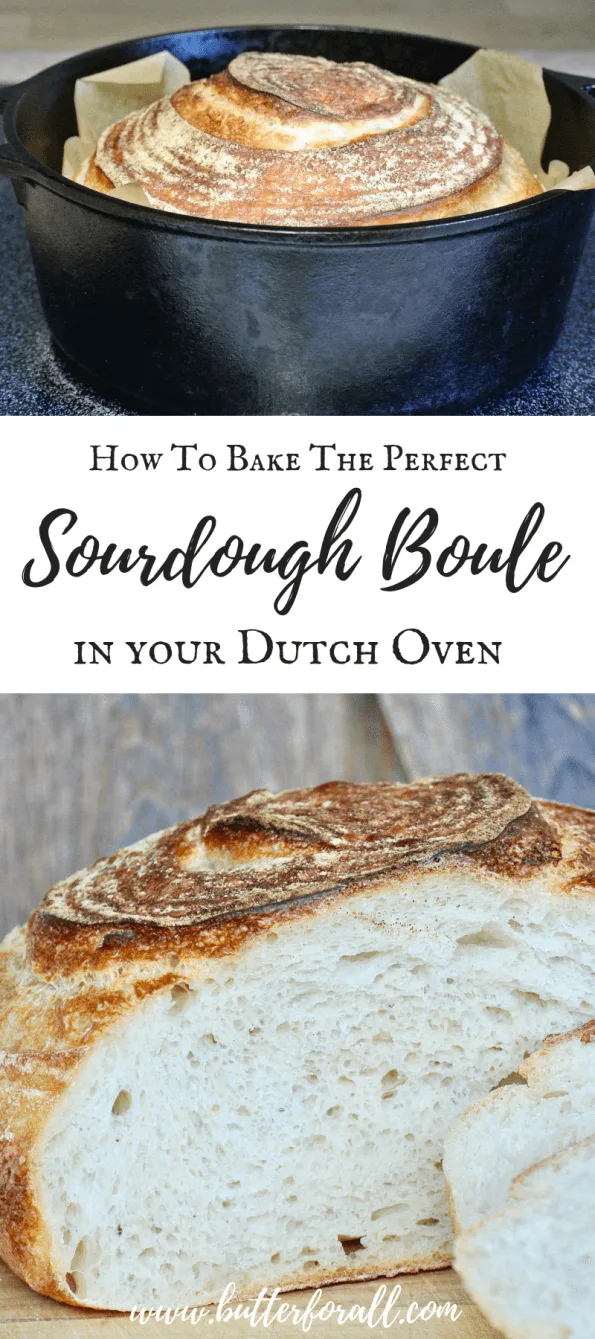
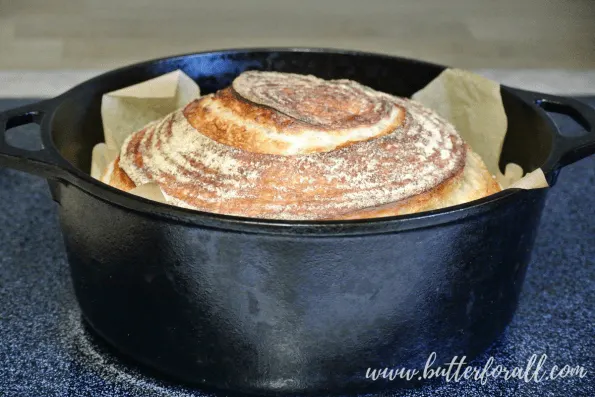
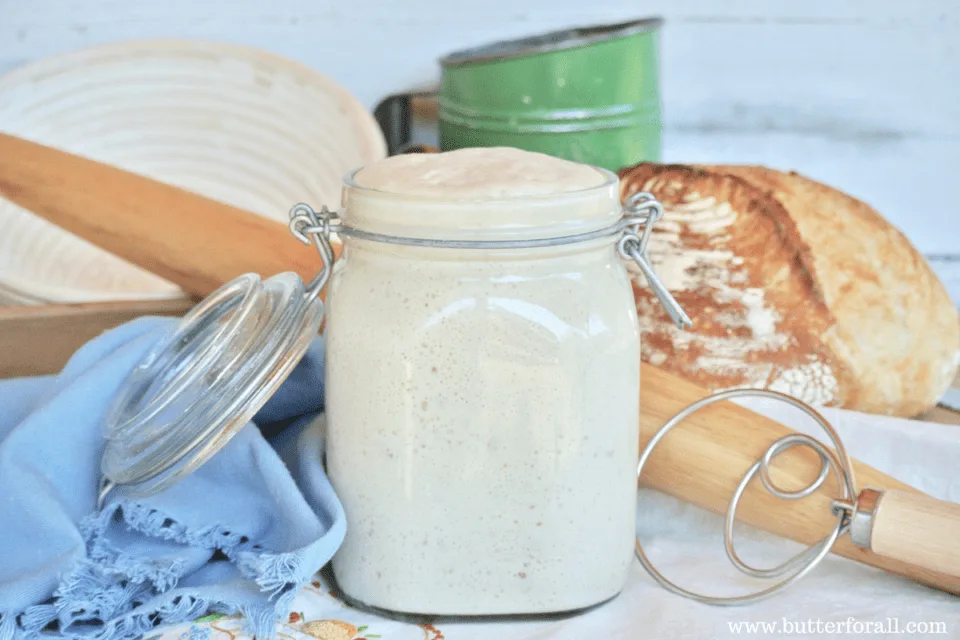
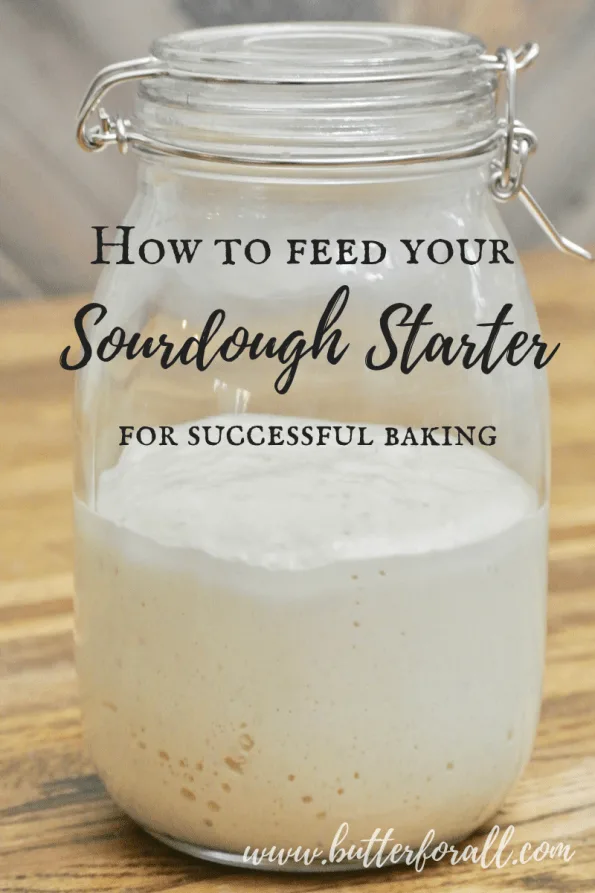
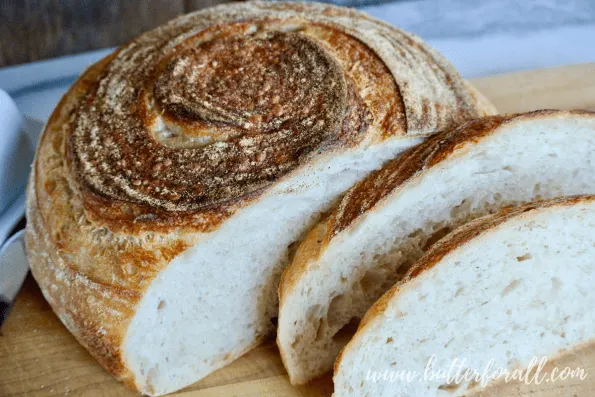
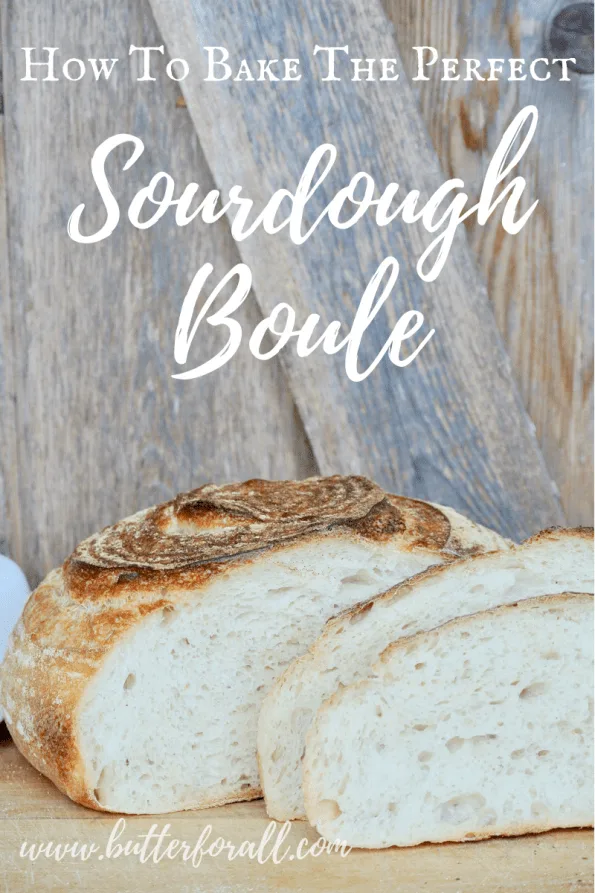

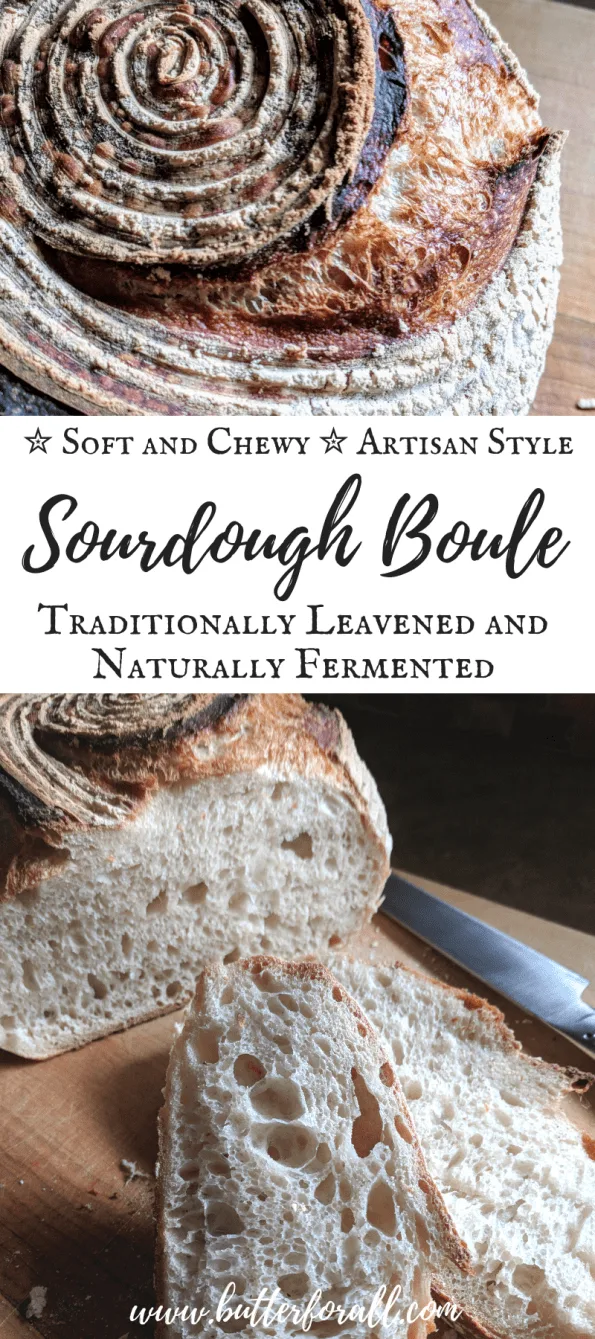
Allyson
Friday 7th of February 2025
This is a wonderful recipe! Soft texture and great rise. Going to keep this one in my files! Thanks!
Patricia M
Saturday 31st of August 2024
I watched the video and followed the directions to a T. I am not new to sour dough or baking. I have a strong starter and everything I make comes out great… except boules! You recipe was easy to follow and everything went exactly to plan until I inverted the cough onto the parchment! 😕. It spread out - to what I think was to much. I scored it and popped into the preheated DO. I did add some ice cubes and put a baking stone on the lower rack. I also have a trivit that fits inside my DO. Baking it now. Hopefully it rises up. 🤞🏻
Butter For All
Friday 6th of September 2024
Hi Patricia!
I'm really excited to hear what happened with this loaf! I hope you'll come back and leave me a note :)
Sharleen
Thursday 28th of March 2024
I’ve been making your Sourdough Boule recipe for a few years and love it! I was wondering if there is a way to make it more sour?
Dave
Thursday 5th of December 2024
@Butter For All, You can also use "Sour Salt" as well. King Arthur has an article on how to use this ingredient to increase its tanginess.
Butter For All
Tuesday 2nd of April 2024
Hi Sharlene!
I'm so happy to hear it! You can try working with a very mature sourdough starter that has more acid buildup. I would recommend splitting your sourdough starter and letting 1/2 ferment until it's very sour. Then use that in place of the active sourdough starter and see if you can manipulate the flavor that way. Otherwise just letting the dough bulk ferment longer will contribute to more flavor as well. The only problem with an extra long ferementation is the possibility of overproofing and losing gluten structure and oven spring. It will be a balancing act until you figure out what works the best. Good luck! And let me know how it goes!
Matthew Strand
Monday 18th of March 2024
I just baked this today and it’s the most amazing sourdough I’ve ever had! However, I did discover that I need a new bread knife.
Butter For All
Tuesday 19th of March 2024
Hi Matthew!
Awesome! I'm so happy that you like this recipe! Yes, a good bread knife is essential for soft squishy bread like this. I really like my Global knife if you're looking for an investment. Take good care and happy baking,
Courtney
Nicole
Sunday 17th of March 2024
I am brand new to the sour dough world and this is the only recipe I have tried so far. I am 100% looking no further! We have just eaten the most glorious home made sour dough bread and it’s all thanks to this recipe. I had found a lot of recipes were so complicated it was overwhelming. This just made sense and made me realise that sour dough doesn’t have to be complicated. I am onto my second loaf now and it’s honestly brilliant. The only part I am stuffing up is actually getting the large amount of starter required BUT I am nearly there! Thank you so much. This recipe is being saved!!
Butter For All
Tuesday 19th of March 2024
Hi Nicole!
You are totally on the right track! It doesn't have to be complicated or intimidating. I'm really happy that this recipe worked so well for you :) There's no hard fast rule about how much to feed your starter. You'll read that it's recommended to feed it 1:1:1 ratio or 1:2:2. That's a good place to start to keep thimngs simple. But to be perfectly honest you do not have to stick with that. You can feed your starter a lot more! Probably almost up to 10 times its own weight. I usually take a dollop of starter, maybe 50g or 100g and then add to it whatever amount flour and water I need to get the amount of starter needed for a project or two. Then I just reserve whatever is leftover and put it away in the fridge until next time. Try it and let me know what happens!
Happy Baking!
Courtney